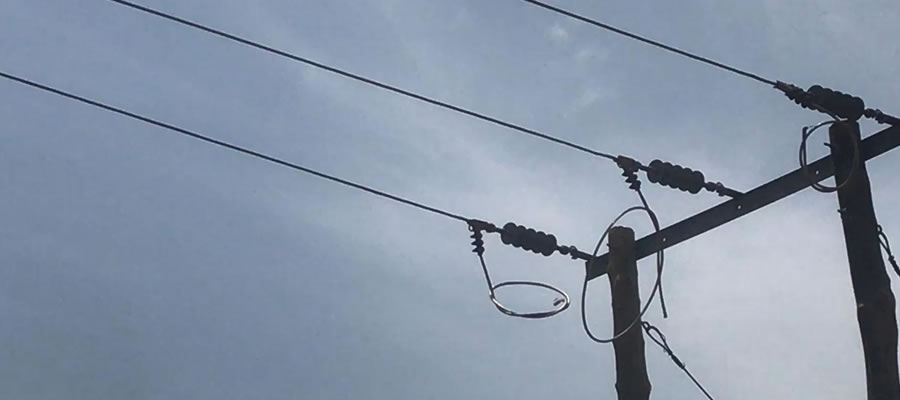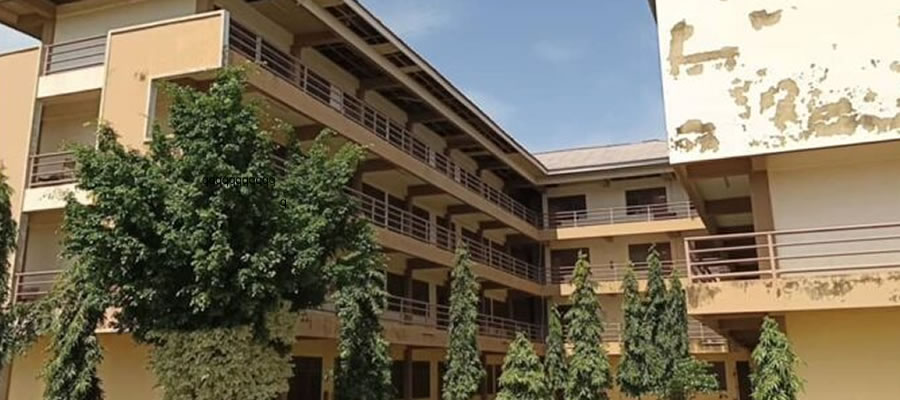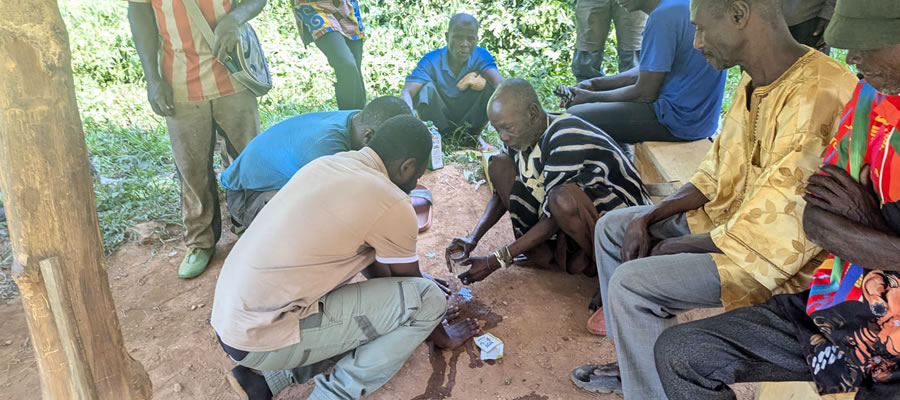

location and size
Nkwanta District is one of the eighteen districts of the Volta Region. It is located in the northern - most part of the Region. It lies between latitudes 7 30° and 8 45° North and longitude 0 10° and 0 45° East. The district is bounded to the North by the Nanumba District of the Northern Region, to the South by the Kadjebi District, to the East by the Republic of Togo and to the West by the newly created Krachi East District. Nkwanta District was carved out of Kete Krachi District in 1989. The District is the largest in the Volta Region in terms of land area. covering a total land area of 4530 sq kms., which represents about 22.02 % of the totals land area of the Volta Region,which is about 20570 sq. kms.
Topology and drainage
Drainage
Nkwanta District is drained by several rivers and streams. The main rivers include part of the Oti River, which covers about 1% of the surface area of the district. Other rivers are the Kpassa, Sabu, Bonakye and Chai Rivers. These rivers take their source from the Buem - Togo Ranges on the eastern border of the district and in flow southwesterly direction into the Oti River. The several tributaries of these rivers and streams serve as both domestic water and water for animals (cattle, pigs, sheep, goats etc.) to the majority of the population. Most of these streams almost invariably dry up during the long dry season.
Climate and vegetation
Climate
Generally, Nkwanta District is characterized by a tropical climate with dry and humid weather conditions. The rainfall repine experienced in the district is the double maxima type, that is from April to July and September to October. The average number of rain days in 86 with extreme annual rainfalls ranging between 922mm to 1874 mm. The dry season is from November to March, during this time the evapotranspiration exceeds water availability at the earth’s surface.
The mean annual maximum temperatures range between 24°° to 390C (76°^ to 103°^), while the mean annual minimum temperatures are between 11oc to 260C (520F to 79°^). January to April are the hottest months while December has the lowest temperatures. Temperatures at the district are high throughout the year for plant growth. However, availability of water is crucial for agriculture during the long dry season of November to March.
Vegetation
The District is covered by three vegetation zones. These are the semi-deciduous forest zones,found mainly on the eastern border of the district. This accounts for about 30% of the vegetative cover. The second zone is the savanna woodland, which extends from the north-eastern part of the district southwards to the zone of the semi-deciduous forest. This accounts for about 50% of the vegetative cover. The final zone is the grassland savanna extending eastwards from the Volta Lake and its Oti arm. It takes about 20% of the vegetative cover of the district. The most common timber species in the district include Odum, Wawa, and Kyenkyen. Due to logging, farming and cutting of fuel wood and charcoal production, the original vegetative cover has been reduced to secondary forests. It is also worth noting that bush burning is rampant during the long dry season. There are two reserves in the district. These are the Kyabobobo reserve and the Chai River reserve.
Geology and soil
Soils
The district is underlain by the Voltarian, the Buem Volcanic formation and the Togo series. The Voltarian, which is mainly shale and mudstone beds and sandy pebbly beds occupy the easteards of the Volta Lake and takes about a quarter of the district. The Togo series consisting of quartzites, phyllites, sandstone, shale, schist and sillicted. limestone is on the eastern border forming the Buem - Togo ranges. The Buem - Volcanic formation consisting of Basaltic, Andesitic and Trachytic lava occupies about two-thirds of the district. These geographic formations are underlying the types of soils in the district. The first group of soils are the laterite integrates found in the savanna - woodland zone of the district.
The second group of soils are the forest Ochrosols and Oxysols found in the forest zone of the district. These soils support variety of crops including yam, cassava, maize, groundnut, cowpea, and sorghum. Rice production is also side spread in the district. There is sufficient justification for mineral exploration in the district. For instance geological reasoning and examination of analogous mineral deposits in the Republic of Togo, such as marble in Togo formations and phosphate in Voltarian rocks should alone warrant a series search for such deposits in similar geological formations in the district. There are also clay deposits in the district especially in Chaiso and its surrounding area, which is suitable for building material and the pottery industry.
physical characteristics
Nkwanta District is one of the Eighteen districts of the Volta Region. It is located in the northern - most part of the Region. It lies between latitudes 7 30° and 8 45° North and longitude 0 10° and 0 45° East. The district is bounded to the North by the Nanumba District of the Northern Region,to the South by the Kadjebi District, to the East by the Republic of Togo and to the West by the newly created Krachi East District. Nkwanta District was carved out of Kete Krachi District in 1989. The District is the largest in the Volta Region in terms of land area. covering a total land area of 4530 sq kms., which represents about 22.02 % of the totals land area of the Volta Region,which is about 20570 sq. kms.
Drainage
Nkwanka District is drained by several rivers and streams. The main rivers include part of the Oti River, which covers about 1% of the surface area of the district. Other rivers are the Kpassa, Sabu, Bonakye and Chai Rivers. These rivers take their source from the Buem - Togo Ranges on the eastern border of the district and in flow southwesterly direction into the Oti River. The several tributaries of these rivers and streams serve as both domestic water and water for animals (cattle, pigs, sheep, goats etc.) to the majority of the population. Most of these streams almost invariably dry up during the long dry season.
Climate
Generally, Nkwanta District is characterized by a tropical climate with dry and humid weather conditions. The rainfall repine experienced in the district is the double maxima type, that is from April to July and September to October. The average number of rain days in 86 with extreme annual rainfalls ranging between 922mm to 1874 mm. The dry season is from November to March, during this time the evapotranspiration exceeds water availability at the earth’s surface.
The mean annual maximum temperatures range between 24°° to 390C (76°^ to 103°^), while the mean annual minimum temperatures are between 11oc to 260C (520F to 79°^). January to April are the hottest months while December has the lowest temperatures. Temperatures at the district are high throughout the year for plant growth. However, availability of water is crucial for agriculture during the long dry season of November to March.
Vegetation
The District is covered by three vegetation zones. These are the semi-deciduous forest zones,found mainly on the eastern border of the district. This accounts for about 30% of the vegetative cover. The second zone is the savanna woodland, which extends from the north-eastern part of the district southwards to the zone of the semi-deciduous forest. This accounts for about 50% of the vegetative cover. The final zone is the grassland savanna extending eastwards from the Volta Lake and its Oti arm. It takes about 20% of the vegetative cover of the district. The most common timber species in the district include Odum, Wawa, and Kyenkyen. Due to logging, farming and cutting of fuel wood and charcoal production, the original vegetative cover has been reduced to secondary forests. It is also worth noting that bush burning is rampant during the long dry season. There are two reserves in the district. These are the Kyabobobo reserve and the Chai River reserve.
Soils
The district is underlain by the Voltarian, the Buem Volcanic formation and the Togo series. The Voltarian, which is mainly shale and mudstone beds and sandy pebbly beds occupy the easteards of the Volta Lake and takes about a quarter of the district. The Togo series consisting of quartzites, phyllites, sandstone, shale, schist and sillicted. limestone is on the eastern border forming the Buem - Togo ranges. The Buem - Volcanic formation consisting of Basaltic, Andesitic and Trachytic lava occupies about two-thirds of the district. These geographic formations are underlying the types of soils in the district. The first group of soils are the laterite integrates found in the savanna - woodland zone of the district.
The second group of soils are the forest Ochrosols and Oxysols found in the forest zone of the district. These soils support variety of crops including yam, cassava, maize, groundnut, cowpea, and sorghum. Rice production is also side spread in the district. There is sufficient justification for mineral exploration in the district. For instance geological reasoning and examination of analogous mineral deposits in the Republic of Togo, such as marble in Togo formations and phosphate in Voltarian rocks should alone warrant a series search for such deposits in similar geological formations in the district. There are also clay deposits in the district especially in Chaiso and its surrounding area, which is suitable for building material and the pottery industry.
Date Created : 11/29/2017 3:48:35 AM












 facebook
facebook
 twitter
twitter
 Youtube
Youtube
 +233 593 831 280
+233 593 831 280 0800 430 430
0800 430 430 GPS: GE-231-4383
GPS: GE-231-4383 info@ghanadistricts.com
info@ghanadistricts.com Box GP1044, Accra, Ghana
Box GP1044, Accra, Ghana